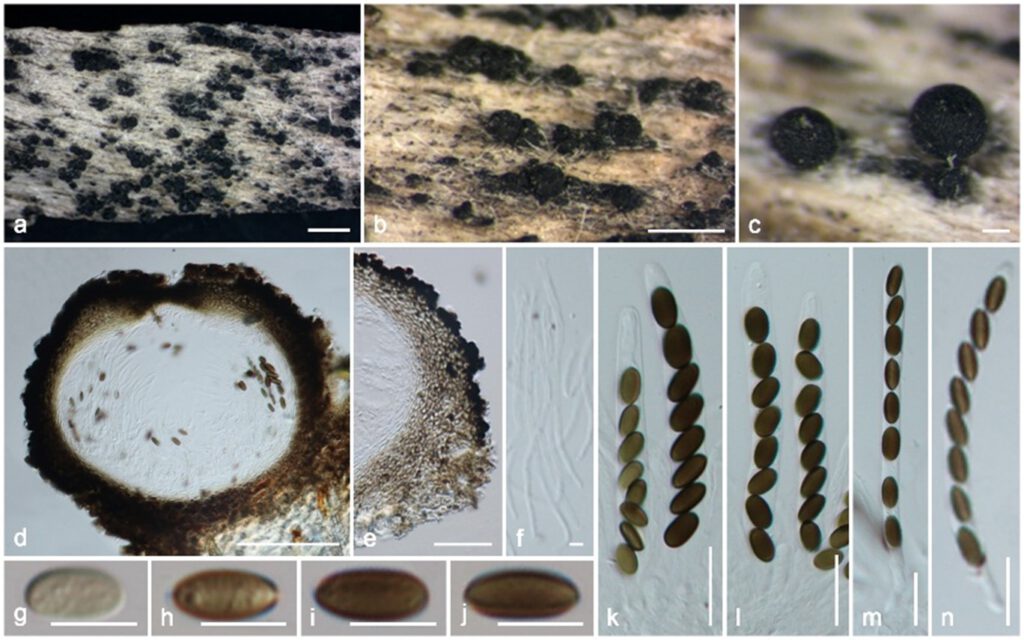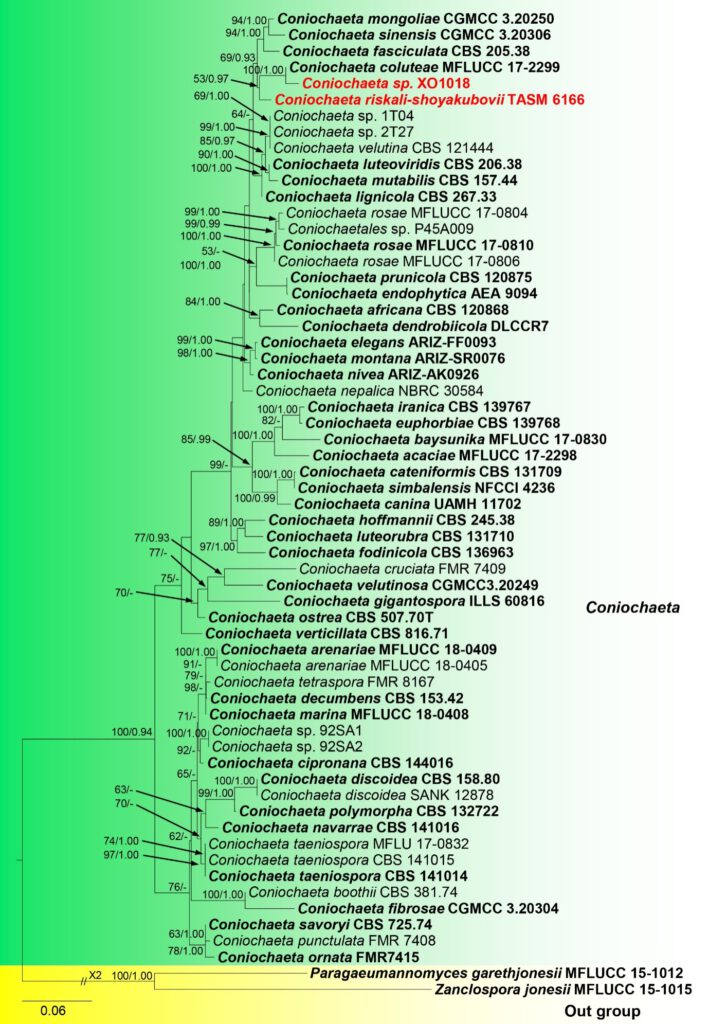Coniochaeta riskali-shoyakubovii Samarak., Gafforov, Teshaboeva & K.D. Hyde,
Index Fungorum number: IF; MycoBank number: MB; Facesoffungi number: FoF 10746; Fig. XX
Etymology – riskali-shoyakubovii (Lat.) in honor of Uzbekistan scientist, Prof. Shoyakubov Riskali Shoyakubovich (1944-2015) for his contribution to the botanical research of Uzbekistan.
Holotype – TASM 6166
Saprobic on a dead branch of the maple tree. Sexual morph: Ascomata 135–370 μm diam. (x̅ = 262 µm, n = 12), forming conspicuous groups in cracks of bark or erumpent through the bark, or growing solitarily, superficial or semi-immersed in the bark, often with only the ostiole visible, black, with a somewhat rough surface, globose. Ostiole centric, depressed, densely filled, 2–3.3 µm (x̅ = 2.5 µm, n = 15) wide, periphyses. Peridium 30–60 µm (x̅ = 46 µm, n = 10), thick brittle when dry, softer when rehydrated, two-layered, inner layer consisting of hyaline to subhyaline, strongly compressed cells, outer layer consisting of densely packed, moderately thick-walled, brown cells, tending to be darker and more isodiametric towards the outside; near the ostiole some protruding, thick-walled, elongated, apically rounded cells and sparse, pale, often apically darker, septate, hairs present, become dark green in 5% KOH. Hamathecium comprising numerous, 2–2.8 µm (x̅ = 2.4 µm, n = 25) wide, filamentous, septate, blunt end paraphyses. Asci 85–120 × 6.5–9.5 µm (x̅ = 105 × 8 µm, n = 15), 8-spored, unitunicate, cylindrical, short pedicellate, apical ring inconspicuous, J- apical ring in Melzer’s reagent. Ascospores 10–14 × 4.5–6.5 µm (x̅ = 12 × 6 µm, n = 35), overlapping uniseriate, ellipsoid, slightly laterally compressed, dark brown, with a conspicuous, straight germ slit across the entire length, smooth-walled, without sheath or appendages. Asexual morph: Undetermined.
Material examined – UZBEKISTAN, Surxondaryo Region, Boysun district, Qizilnaur village, South-Western Hissar Mountains, on the dead branch of Acer sp. (Sapindaceae), 13 May 2016, Yusufjon Gafforov, Shaxnoza Teshaboeva YG-S31 (holotype: TASM 6166; isotype: MFLU 17-0051).
GenBank numbers – ITS = XX, LSU = XX, SSU = XX, TEF1-α = XX.
Notes – The morphological characters of Coniochaeta riskali-shoyakubovii fit into the generic concept of Coniochaeta in having globose ascomata, cylindrical asci, and ellipsoid ascospores with a straight germ slit across the entire length. Coniochaeta coluteae has ascomata with globe-like outer structures, an absence of setae, a long ostiolar neck, and oval to ellipsoid ascospores, which differ from those of C. riskali-shoyakubovii (Samarakoon et al. 2018). The combined LSU-ITS phylogenetic analyses show that our collection (TASM 6166) clusters as basal to the C. coluteae (MFLUCC 17-2299)-C. xx (XO1018) clade with (53% ML, 0.97 BYPP; Fig. XX). BLASTn search of LSU of C. riskali-shoyakubovii is similar to those of C. rosae (MFLUCC 17-0806, 99.4% similarity) and C. mutabilis (CBS 206.73, 99% similarity), while ITS is similar that of C. mongoliae (CGMCC3.20250, 97% similarity). In recent studies, new Coniochaeta species have been introduced from Uzbekistan as C. acaciae (Acacia sp.), C. baysunika (Rosa sp.), C. coluteae (Colutea paulsenii) and C. rosae (Rosa spp.) (Samarakoon et al. 2018, Wanasinghe et al. 2018). Based on morphology and phylogeny, we introduced another new species from Uzbekistan C. riskali-shoyakubovii.

Fig. XX Coniochaeta riskali-shoyakubovii (MFLU 17-0051 isotype) a–c Appearance of ascomata on the substrate. d Vertical sections of ascoma. e Peridium. f Paraphyses. g–j Ascospores. k–n Asci. Scale bars: a = 1000 µm, b = 500 µm, c,d = 100 µm, e = 50 µm, k–n = 20 µm, g–j = 10 µm, f = 5 µm.

Fig. XX Phylogenetic tree generated from maximum likelihood analysis (RAxML) based on a combined LSU-ITS sequence dataset. Sixty one strains are included in the combined analyses which comprise 1392 characters (827 characters for LSU, 565 characters for ITS) after alignment. Paragaeumannomyces garethjonesii (MFLUCC 15-1012) and Zanclospora jonesii (MFLUCC 15-1015) are used as the outgroup taxon. Single gene analyses were also performed to compare the topology and clade stability with combined gene analyses. Tree topology of the maximum likelihood analysis is similar to the Bayesian inference analysis. The best RaxML tree with a final likelihood values of -7641.0294 is presented. The matrix had 511 distinct alignment patterns, with 69.9% undetermined characters or gaps. Estimated base frequencies were as follows: A = 0. 2322, C = 0. 2618, G = 0. 3022, T = 0. 2039; substitution rates AC = 1.4010, AG = 1.9398, AT = 1.3856, CG = 1.3748, CT = 8.4597, GT = 1.000000; gamma distribution shape parameter α = 0.479. Bootstrap values for maximum likelihood (ML) equal to or greater than 50% and clade credibility values greater than 0.90 (the rounding of values to 2 decimal proportions) from Bayesian inference analysis are labeled on the nodes. Ex-type strains are in bold. The new isolate is in red.
